An Analysis of ESSA: Progress, Impact, and Recommendations
VerifiedAdded on 2022/12/26
|9
|2509
|2
Report
AI Summary
This report provides an in-depth analysis of the Every Student Succeeds Act (ESSA), enacted in 2015 to reform the Elementary and Secondary Education Act. The paper examines the law's objectives, including empowering states, reducing federal mandates, and improving student outcomes, particularly in high school graduation rates and college enrollment. It contrasts ESSA with its predecessor, the No Child Left Behind Act (NCLB), highlighting changes in accountability, testing, and teacher evaluation. The report discusses the shift of responsibility from the federal government to states and the impact on hiring, recruitment, and standards. It also addresses the challenges and areas needing improvement, such as school climate, family engagement, and early childhood education. The paper concludes with recommendations for enhancing ESSA's effectiveness by incorporating measures of school climate, promoting family engagement, and connecting with early childhood educators to address the issues faced by students and create a positive learning environment. The overall aim is to create a healthy environment for children to become efficient in their academics and become the future of the state.
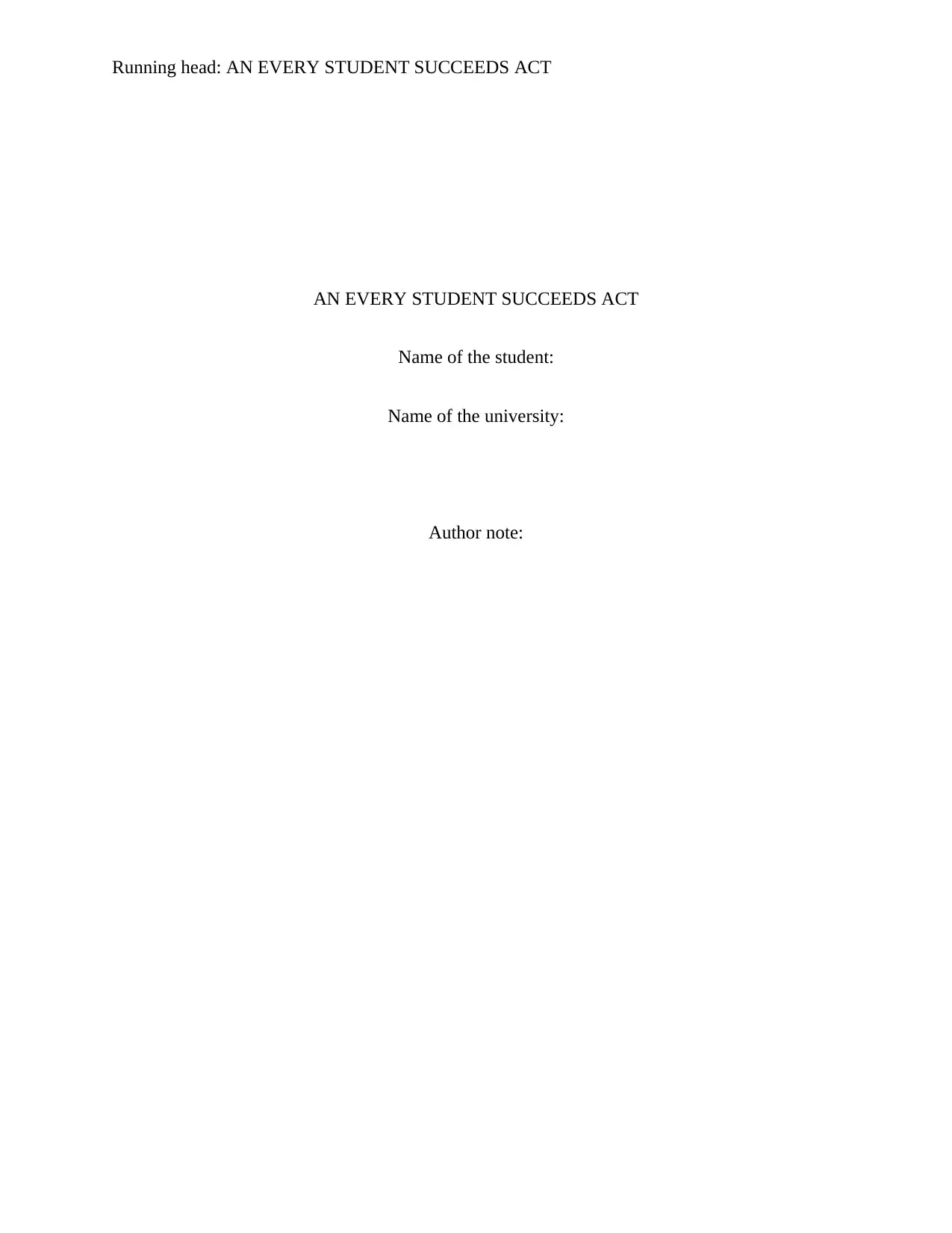
Running head: AN EVERY STUDENT SUCCEEDS ACT
AN EVERY STUDENT SUCCEEDS ACT
Name of the student:
Name of the university:
Author note:
AN EVERY STUDENT SUCCEEDS ACT
Name of the student:
Name of the university:
Author note:
Paraphrase This Document
Need a fresh take? Get an instant paraphrase of this document with our AI Paraphraser
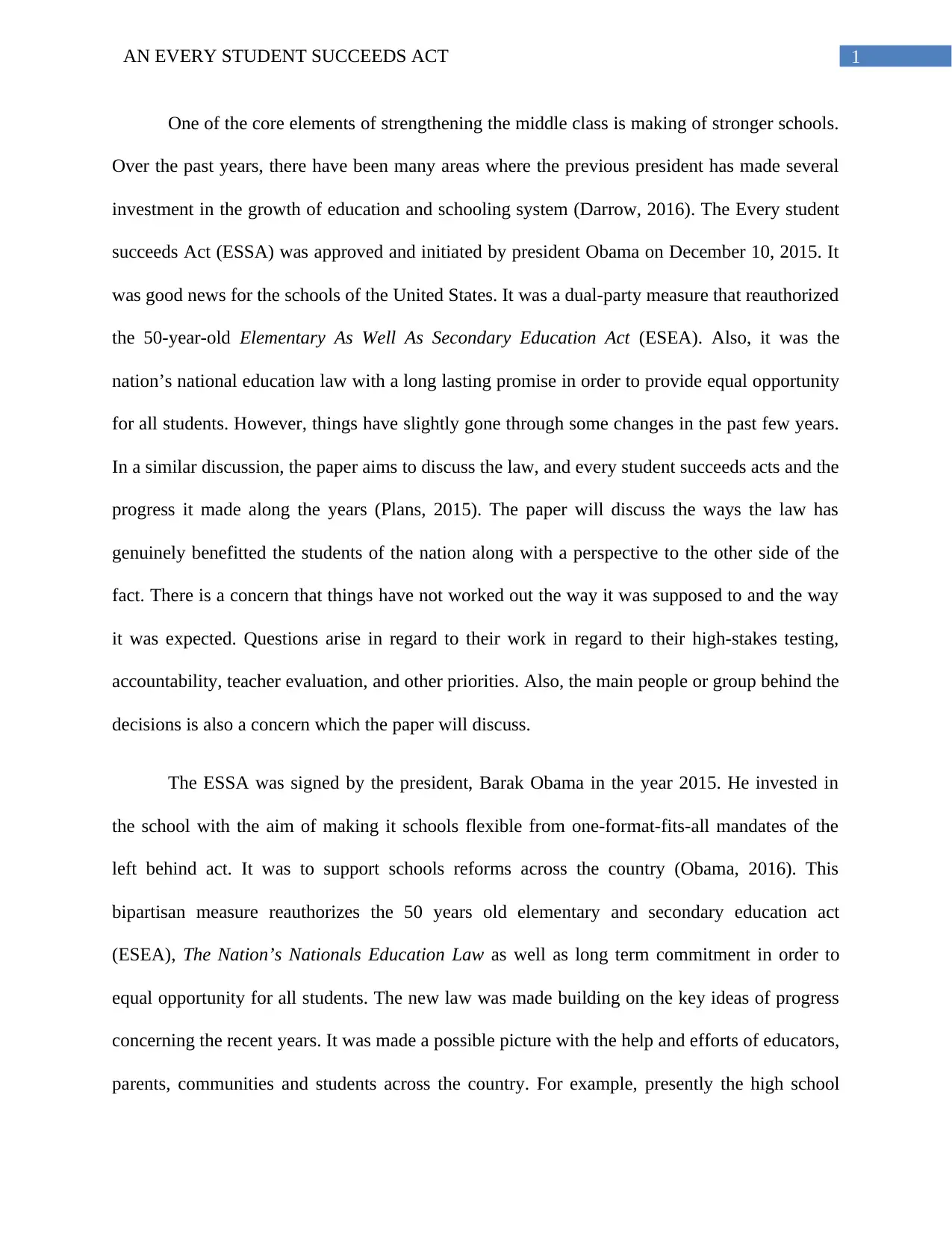
1AN EVERY STUDENT SUCCEEDS ACT
One of the core elements of strengthening the middle class is making of stronger schools.
Over the past years, there have been many areas where the previous president has made several
investment in the growth of education and schooling system (Darrow, 2016). The Every student
succeeds Act (ESSA) was approved and initiated by president Obama on December 10, 2015. It
was good news for the schools of the United States. It was a dual-party measure that reauthorized
the 50-year-old Elementary As Well As Secondary Education Act (ESEA). Also, it was the
nation’s national education law with a long lasting promise in order to provide equal opportunity
for all students. However, things have slightly gone through some changes in the past few years.
In a similar discussion, the paper aims to discuss the law, and every student succeeds acts and the
progress it made along the years (Plans, 2015). The paper will discuss the ways the law has
genuinely benefitted the students of the nation along with a perspective to the other side of the
fact. There is a concern that things have not worked out the way it was supposed to and the way
it was expected. Questions arise in regard to their work in regard to their high-stakes testing,
accountability, teacher evaluation, and other priorities. Also, the main people or group behind the
decisions is also a concern which the paper will discuss.
The ESSA was signed by the president, Barak Obama in the year 2015. He invested in
the school with the aim of making it schools flexible from one-format-fits-all mandates of the
left behind act. It was to support schools reforms across the country (Obama, 2016). This
bipartisan measure reauthorizes the 50 years old elementary and secondary education act
(ESEA), The Nation’s Nationals Education Law as well as long term commitment in order to
equal opportunity for all students. The new law was made building on the key ideas of progress
concerning the recent years. It was made a possible picture with the help and efforts of educators,
parents, communities and students across the country. For example, presently the high school
One of the core elements of strengthening the middle class is making of stronger schools.
Over the past years, there have been many areas where the previous president has made several
investment in the growth of education and schooling system (Darrow, 2016). The Every student
succeeds Act (ESSA) was approved and initiated by president Obama on December 10, 2015. It
was good news for the schools of the United States. It was a dual-party measure that reauthorized
the 50-year-old Elementary As Well As Secondary Education Act (ESEA). Also, it was the
nation’s national education law with a long lasting promise in order to provide equal opportunity
for all students. However, things have slightly gone through some changes in the past few years.
In a similar discussion, the paper aims to discuss the law, and every student succeeds acts and the
progress it made along the years (Plans, 2015). The paper will discuss the ways the law has
genuinely benefitted the students of the nation along with a perspective to the other side of the
fact. There is a concern that things have not worked out the way it was supposed to and the way
it was expected. Questions arise in regard to their work in regard to their high-stakes testing,
accountability, teacher evaluation, and other priorities. Also, the main people or group behind the
decisions is also a concern which the paper will discuss.
The ESSA was signed by the president, Barak Obama in the year 2015. He invested in
the school with the aim of making it schools flexible from one-format-fits-all mandates of the
left behind act. It was to support schools reforms across the country (Obama, 2016). This
bipartisan measure reauthorizes the 50 years old elementary and secondary education act
(ESEA), The Nation’s Nationals Education Law as well as long term commitment in order to
equal opportunity for all students. The new law was made building on the key ideas of progress
concerning the recent years. It was made a possible picture with the help and efforts of educators,
parents, communities and students across the country. For example, presently the high school
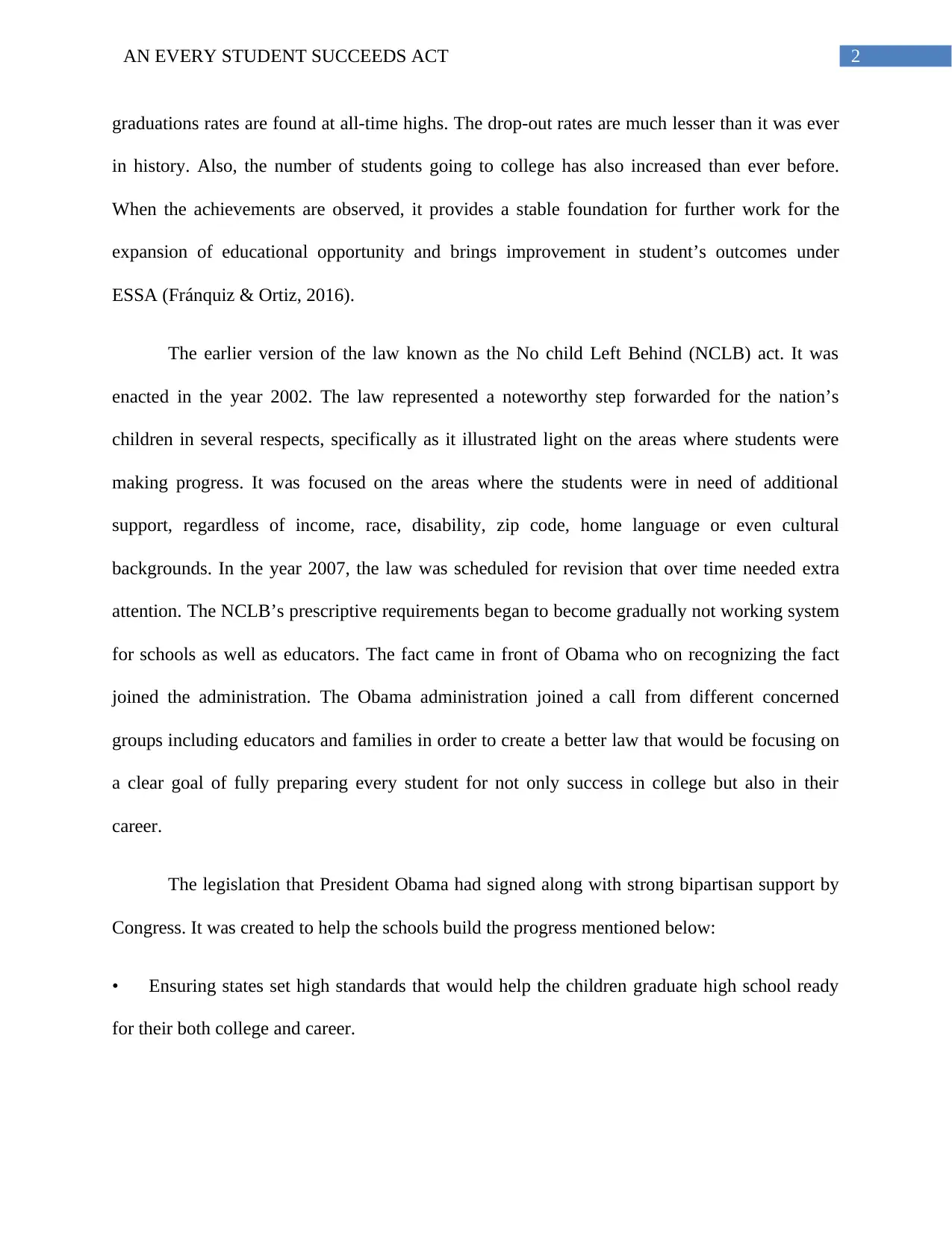
2AN EVERY STUDENT SUCCEEDS ACT
graduations rates are found at all-time highs. The drop-out rates are much lesser than it was ever
in history. Also, the number of students going to college has also increased than ever before.
When the achievements are observed, it provides a stable foundation for further work for the
expansion of educational opportunity and brings improvement in student’s outcomes under
ESSA (Fránquiz & Ortiz, 2016).
The earlier version of the law known as the No child Left Behind (NCLB) act. It was
enacted in the year 2002. The law represented a noteworthy step forwarded for the nation’s
children in several respects, specifically as it illustrated light on the areas where students were
making progress. It was focused on the areas where the students were in need of additional
support, regardless of income, race, disability, zip code, home language or even cultural
backgrounds. In the year 2007, the law was scheduled for revision that over time needed extra
attention. The NCLB’s prescriptive requirements began to become gradually not working system
for schools as well as educators. The fact came in front of Obama who on recognizing the fact
joined the administration. The Obama administration joined a call from different concerned
groups including educators and families in order to create a better law that would be focusing on
a clear goal of fully preparing every student for not only success in college but also in their
career.
The legislation that President Obama had signed along with strong bipartisan support by
Congress. It was created to help the schools build the progress mentioned below:
• Ensuring states set high standards that would help the children graduate high school ready
for their both college and career.
graduations rates are found at all-time highs. The drop-out rates are much lesser than it was ever
in history. Also, the number of students going to college has also increased than ever before.
When the achievements are observed, it provides a stable foundation for further work for the
expansion of educational opportunity and brings improvement in student’s outcomes under
ESSA (Fránquiz & Ortiz, 2016).
The earlier version of the law known as the No child Left Behind (NCLB) act. It was
enacted in the year 2002. The law represented a noteworthy step forwarded for the nation’s
children in several respects, specifically as it illustrated light on the areas where students were
making progress. It was focused on the areas where the students were in need of additional
support, regardless of income, race, disability, zip code, home language or even cultural
backgrounds. In the year 2007, the law was scheduled for revision that over time needed extra
attention. The NCLB’s prescriptive requirements began to become gradually not working system
for schools as well as educators. The fact came in front of Obama who on recognizing the fact
joined the administration. The Obama administration joined a call from different concerned
groups including educators and families in order to create a better law that would be focusing on
a clear goal of fully preparing every student for not only success in college but also in their
career.
The legislation that President Obama had signed along with strong bipartisan support by
Congress. It was created to help the schools build the progress mentioned below:
• Ensuring states set high standards that would help the children graduate high school ready
for their both college and career.
⊘ This is a preview!⊘
Do you want full access?
Subscribe today to unlock all pages.

Trusted by 1+ million students worldwide
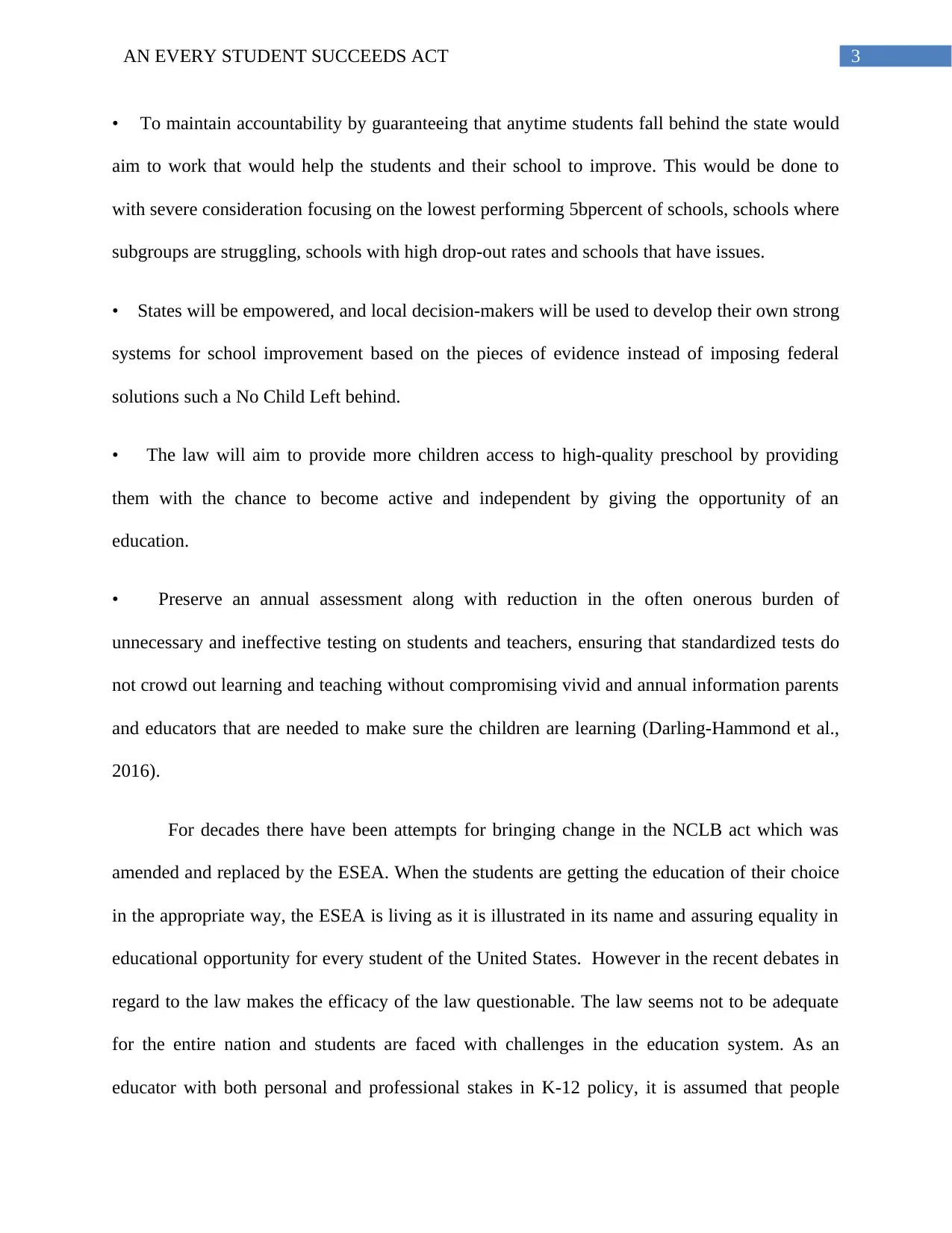
3AN EVERY STUDENT SUCCEEDS ACT
• To maintain accountability by guaranteeing that anytime students fall behind the state would
aim to work that would help the students and their school to improve. This would be done to
with severe consideration focusing on the lowest performing 5bpercent of schools, schools where
subgroups are struggling, schools with high drop-out rates and schools that have issues.
• States will be empowered, and local decision-makers will be used to develop their own strong
systems for school improvement based on the pieces of evidence instead of imposing federal
solutions such a No Child Left behind.
• The law will aim to provide more children access to high-quality preschool by providing
them with the chance to become active and independent by giving the opportunity of an
education.
• Preserve an annual assessment along with reduction in the often onerous burden of
unnecessary and ineffective testing on students and teachers, ensuring that standardized tests do
not crowd out learning and teaching without compromising vivid and annual information parents
and educators that are needed to make sure the children are learning (Darling-Hammond et al.,
2016).
For decades there have been attempts for bringing change in the NCLB act which was
amended and replaced by the ESEA. When the students are getting the education of their choice
in the appropriate way, the ESEA is living as it is illustrated in its name and assuring equality in
educational opportunity for every student of the United States. However in the recent debates in
regard to the law makes the efficacy of the law questionable. The law seems not to be adequate
for the entire nation and students are faced with challenges in the education system. As an
educator with both personal and professional stakes in K-12 policy, it is assumed that people
• To maintain accountability by guaranteeing that anytime students fall behind the state would
aim to work that would help the students and their school to improve. This would be done to
with severe consideration focusing on the lowest performing 5bpercent of schools, schools where
subgroups are struggling, schools with high drop-out rates and schools that have issues.
• States will be empowered, and local decision-makers will be used to develop their own strong
systems for school improvement based on the pieces of evidence instead of imposing federal
solutions such a No Child Left behind.
• The law will aim to provide more children access to high-quality preschool by providing
them with the chance to become active and independent by giving the opportunity of an
education.
• Preserve an annual assessment along with reduction in the often onerous burden of
unnecessary and ineffective testing on students and teachers, ensuring that standardized tests do
not crowd out learning and teaching without compromising vivid and annual information parents
and educators that are needed to make sure the children are learning (Darling-Hammond et al.,
2016).
For decades there have been attempts for bringing change in the NCLB act which was
amended and replaced by the ESEA. When the students are getting the education of their choice
in the appropriate way, the ESEA is living as it is illustrated in its name and assuring equality in
educational opportunity for every student of the United States. However in the recent debates in
regard to the law makes the efficacy of the law questionable. The law seems not to be adequate
for the entire nation and students are faced with challenges in the education system. As an
educator with both personal and professional stakes in K-12 policy, it is assumed that people
Paraphrase This Document
Need a fresh take? Get an instant paraphrase of this document with our AI Paraphraser
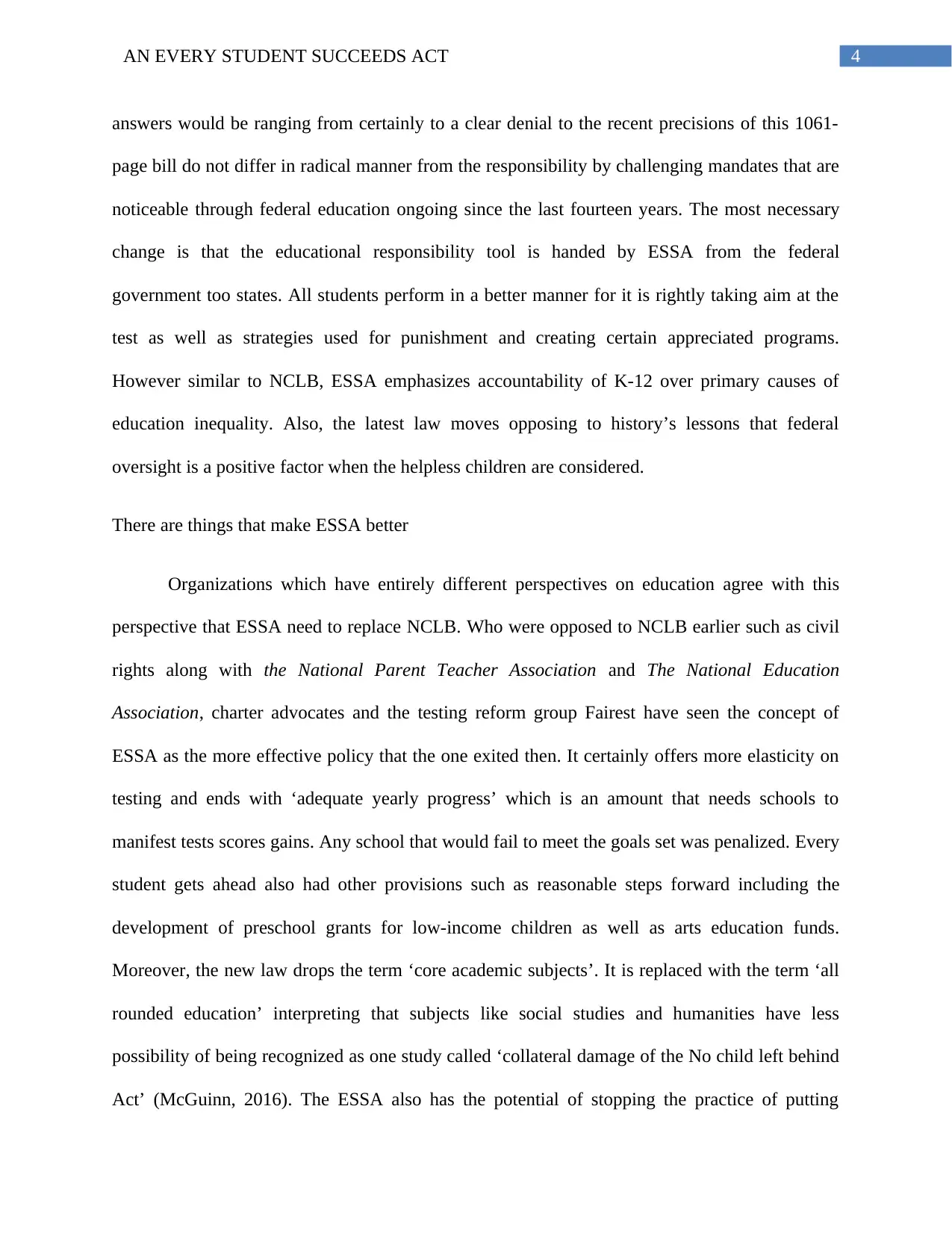
4AN EVERY STUDENT SUCCEEDS ACT
answers would be ranging from certainly to a clear denial to the recent precisions of this 1061-
page bill do not differ in radical manner from the responsibility by challenging mandates that are
noticeable through federal education ongoing since the last fourteen years. The most necessary
change is that the educational responsibility tool is handed by ESSA from the federal
government too states. All students perform in a better manner for it is rightly taking aim at the
test as well as strategies used for punishment and creating certain appreciated programs.
However similar to NCLB, ESSA emphasizes accountability of K-12 over primary causes of
education inequality. Also, the latest law moves opposing to history’s lessons that federal
oversight is a positive factor when the helpless children are considered.
There are things that make ESSA better
Organizations which have entirely different perspectives on education agree with this
perspective that ESSA need to replace NCLB. Who were opposed to NCLB earlier such as civil
rights along with the National Parent Teacher Association and The National Education
Association, charter advocates and the testing reform group Fairest have seen the concept of
ESSA as the more effective policy that the one exited then. It certainly offers more elasticity on
testing and ends with ‘adequate yearly progress’ which is an amount that needs schools to
manifest tests scores gains. Any school that would fail to meet the goals set was penalized. Every
student gets ahead also had other provisions such as reasonable steps forward including the
development of preschool grants for low-income children as well as arts education funds.
Moreover, the new law drops the term ‘core academic subjects’. It is replaced with the term ‘all
rounded education’ interpreting that subjects like social studies and humanities have less
possibility of being recognized as one study called ‘collateral damage of the No child left behind
Act’ (McGuinn, 2016). The ESSA also has the potential of stopping the practice of putting
answers would be ranging from certainly to a clear denial to the recent precisions of this 1061-
page bill do not differ in radical manner from the responsibility by challenging mandates that are
noticeable through federal education ongoing since the last fourteen years. The most necessary
change is that the educational responsibility tool is handed by ESSA from the federal
government too states. All students perform in a better manner for it is rightly taking aim at the
test as well as strategies used for punishment and creating certain appreciated programs.
However similar to NCLB, ESSA emphasizes accountability of K-12 over primary causes of
education inequality. Also, the latest law moves opposing to history’s lessons that federal
oversight is a positive factor when the helpless children are considered.
There are things that make ESSA better
Organizations which have entirely different perspectives on education agree with this
perspective that ESSA need to replace NCLB. Who were opposed to NCLB earlier such as civil
rights along with the National Parent Teacher Association and The National Education
Association, charter advocates and the testing reform group Fairest have seen the concept of
ESSA as the more effective policy that the one exited then. It certainly offers more elasticity on
testing and ends with ‘adequate yearly progress’ which is an amount that needs schools to
manifest tests scores gains. Any school that would fail to meet the goals set was penalized. Every
student gets ahead also had other provisions such as reasonable steps forward including the
development of preschool grants for low-income children as well as arts education funds.
Moreover, the new law drops the term ‘core academic subjects’. It is replaced with the term ‘all
rounded education’ interpreting that subjects like social studies and humanities have less
possibility of being recognized as one study called ‘collateral damage of the No child left behind
Act’ (McGuinn, 2016). The ESSA also has the potential of stopping the practice of putting
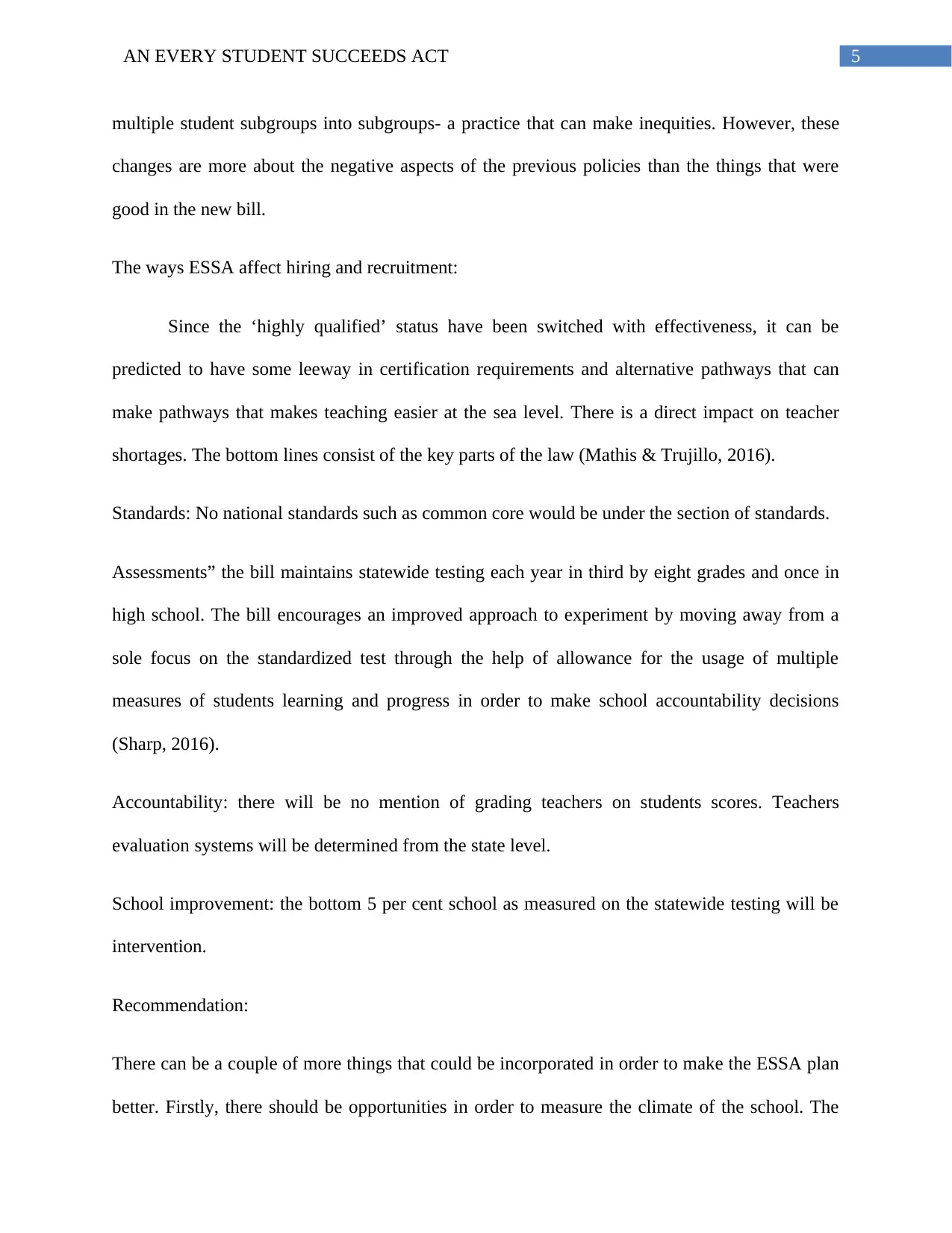
5AN EVERY STUDENT SUCCEEDS ACT
multiple student subgroups into subgroups- a practice that can make inequities. However, these
changes are more about the negative aspects of the previous policies than the things that were
good in the new bill.
The ways ESSA affect hiring and recruitment:
Since the ‘highly qualified’ status have been switched with effectiveness, it can be
predicted to have some leeway in certification requirements and alternative pathways that can
make pathways that makes teaching easier at the sea level. There is a direct impact on teacher
shortages. The bottom lines consist of the key parts of the law (Mathis & Trujillo, 2016).
Standards: No national standards such as common core would be under the section of standards.
Assessments” the bill maintains statewide testing each year in third by eight grades and once in
high school. The bill encourages an improved approach to experiment by moving away from a
sole focus on the standardized test through the help of allowance for the usage of multiple
measures of students learning and progress in order to make school accountability decisions
(Sharp, 2016).
Accountability: there will be no mention of grading teachers on students scores. Teachers
evaluation systems will be determined from the state level.
School improvement: the bottom 5 per cent school as measured on the statewide testing will be
intervention.
Recommendation:
There can be a couple of more things that could be incorporated in order to make the ESSA plan
better. Firstly, there should be opportunities in order to measure the climate of the school. The
multiple student subgroups into subgroups- a practice that can make inequities. However, these
changes are more about the negative aspects of the previous policies than the things that were
good in the new bill.
The ways ESSA affect hiring and recruitment:
Since the ‘highly qualified’ status have been switched with effectiveness, it can be
predicted to have some leeway in certification requirements and alternative pathways that can
make pathways that makes teaching easier at the sea level. There is a direct impact on teacher
shortages. The bottom lines consist of the key parts of the law (Mathis & Trujillo, 2016).
Standards: No national standards such as common core would be under the section of standards.
Assessments” the bill maintains statewide testing each year in third by eight grades and once in
high school. The bill encourages an improved approach to experiment by moving away from a
sole focus on the standardized test through the help of allowance for the usage of multiple
measures of students learning and progress in order to make school accountability decisions
(Sharp, 2016).
Accountability: there will be no mention of grading teachers on students scores. Teachers
evaluation systems will be determined from the state level.
School improvement: the bottom 5 per cent school as measured on the statewide testing will be
intervention.
Recommendation:
There can be a couple of more things that could be incorporated in order to make the ESSA plan
better. Firstly, there should be opportunities in order to measure the climate of the school. The
⊘ This is a preview!⊘
Do you want full access?
Subscribe today to unlock all pages.

Trusted by 1+ million students worldwide
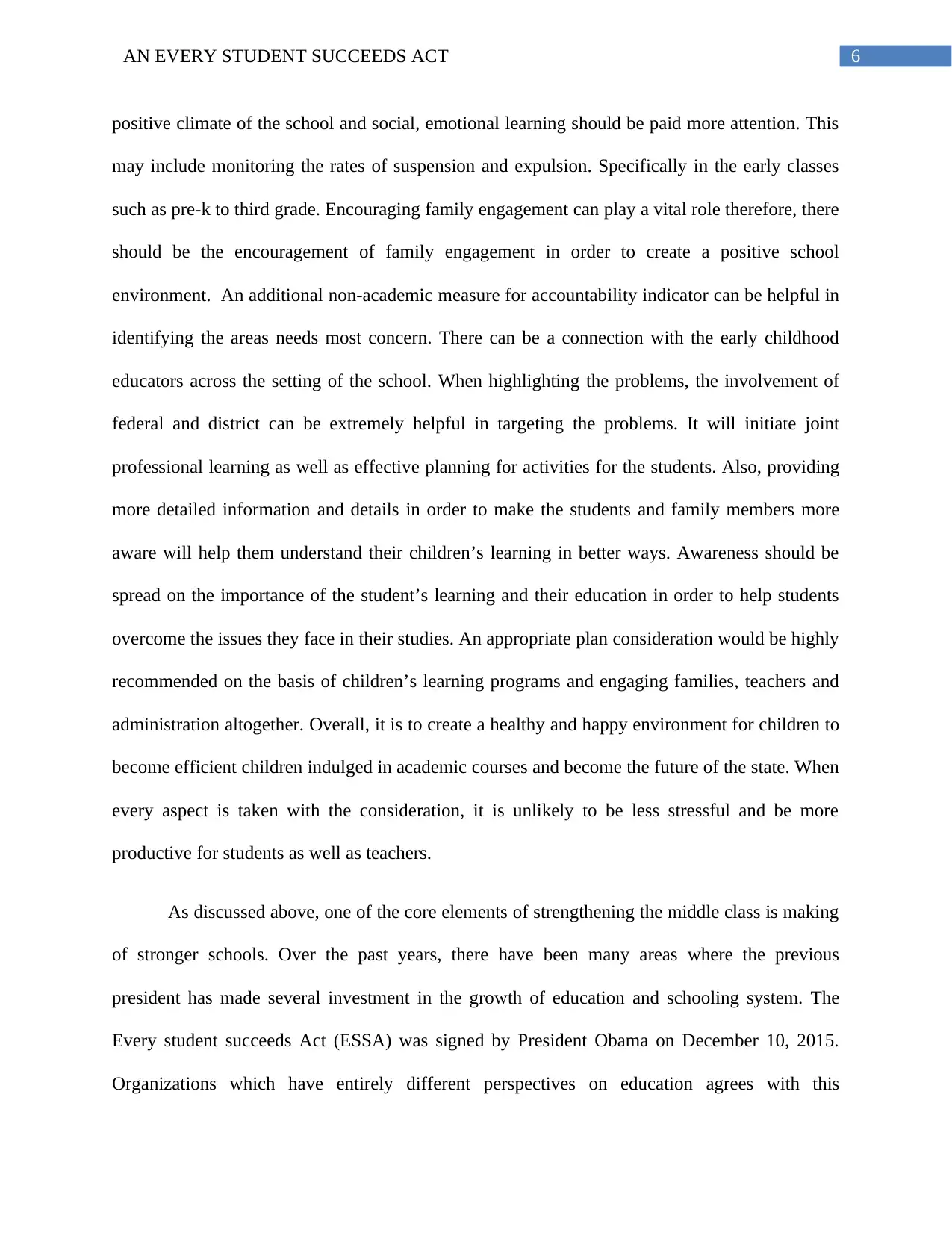
6AN EVERY STUDENT SUCCEEDS ACT
positive climate of the school and social, emotional learning should be paid more attention. This
may include monitoring the rates of suspension and expulsion. Specifically in the early classes
such as pre-k to third grade. Encouraging family engagement can play a vital role therefore, there
should be the encouragement of family engagement in order to create a positive school
environment. An additional non-academic measure for accountability indicator can be helpful in
identifying the areas needs most concern. There can be a connection with the early childhood
educators across the setting of the school. When highlighting the problems, the involvement of
federal and district can be extremely helpful in targeting the problems. It will initiate joint
professional learning as well as effective planning for activities for the students. Also, providing
more detailed information and details in order to make the students and family members more
aware will help them understand their children’s learning in better ways. Awareness should be
spread on the importance of the student’s learning and their education in order to help students
overcome the issues they face in their studies. An appropriate plan consideration would be highly
recommended on the basis of children’s learning programs and engaging families, teachers and
administration altogether. Overall, it is to create a healthy and happy environment for children to
become efficient children indulged in academic courses and become the future of the state. When
every aspect is taken with the consideration, it is unlikely to be less stressful and be more
productive for students as well as teachers.
As discussed above, one of the core elements of strengthening the middle class is making
of stronger schools. Over the past years, there have been many areas where the previous
president has made several investment in the growth of education and schooling system. The
Every student succeeds Act (ESSA) was signed by President Obama on December 10, 2015.
Organizations which have entirely different perspectives on education agrees with this
positive climate of the school and social, emotional learning should be paid more attention. This
may include monitoring the rates of suspension and expulsion. Specifically in the early classes
such as pre-k to third grade. Encouraging family engagement can play a vital role therefore, there
should be the encouragement of family engagement in order to create a positive school
environment. An additional non-academic measure for accountability indicator can be helpful in
identifying the areas needs most concern. There can be a connection with the early childhood
educators across the setting of the school. When highlighting the problems, the involvement of
federal and district can be extremely helpful in targeting the problems. It will initiate joint
professional learning as well as effective planning for activities for the students. Also, providing
more detailed information and details in order to make the students and family members more
aware will help them understand their children’s learning in better ways. Awareness should be
spread on the importance of the student’s learning and their education in order to help students
overcome the issues they face in their studies. An appropriate plan consideration would be highly
recommended on the basis of children’s learning programs and engaging families, teachers and
administration altogether. Overall, it is to create a healthy and happy environment for children to
become efficient children indulged in academic courses and become the future of the state. When
every aspect is taken with the consideration, it is unlikely to be less stressful and be more
productive for students as well as teachers.
As discussed above, one of the core elements of strengthening the middle class is making
of stronger schools. Over the past years, there have been many areas where the previous
president has made several investment in the growth of education and schooling system. The
Every student succeeds Act (ESSA) was signed by President Obama on December 10, 2015.
Organizations which have entirely different perspectives on education agrees with this
Paraphrase This Document
Need a fresh take? Get an instant paraphrase of this document with our AI Paraphraser
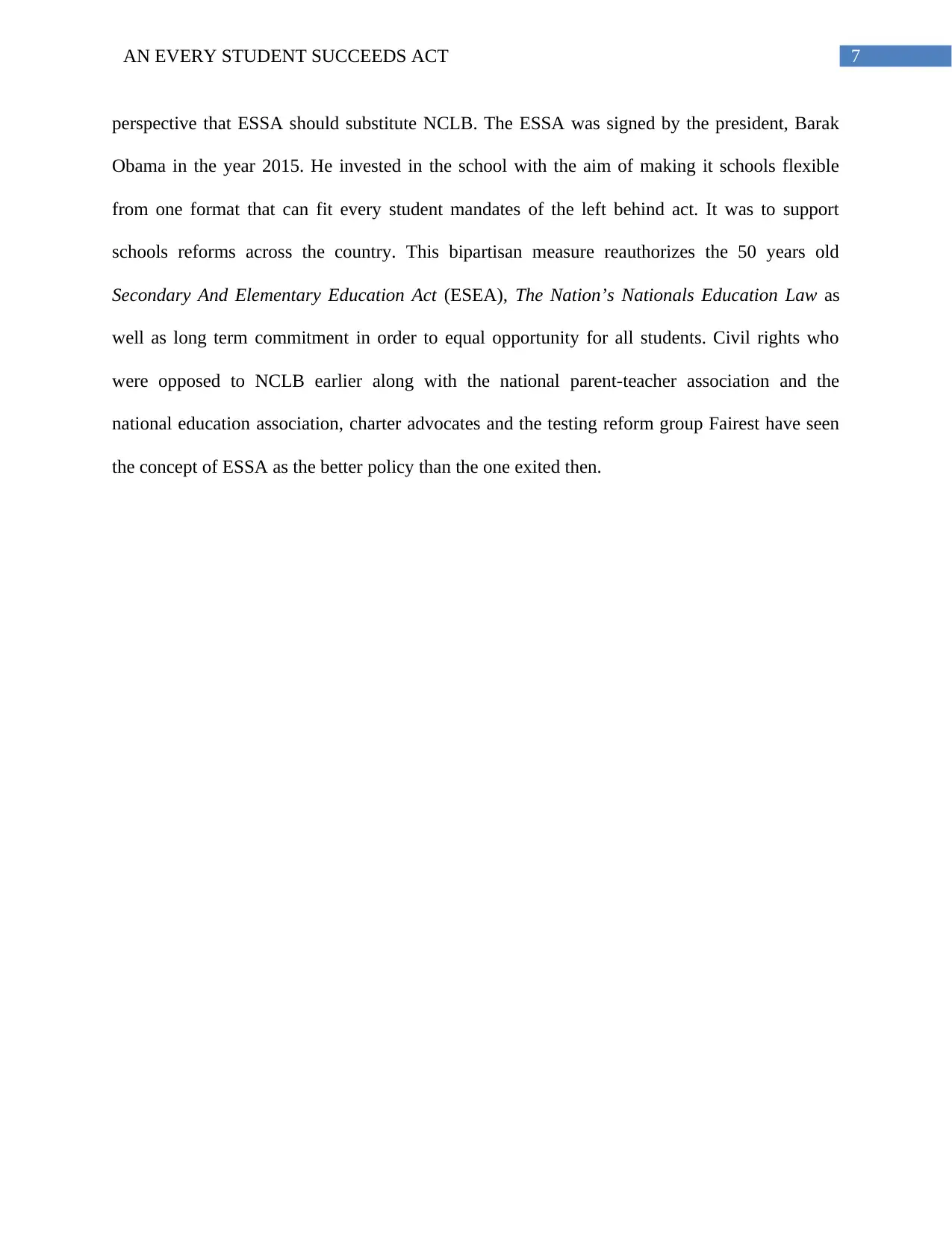
7AN EVERY STUDENT SUCCEEDS ACT
perspective that ESSA should substitute NCLB. The ESSA was signed by the president, Barak
Obama in the year 2015. He invested in the school with the aim of making it schools flexible
from one format that can fit every student mandates of the left behind act. It was to support
schools reforms across the country. This bipartisan measure reauthorizes the 50 years old
Secondary And Elementary Education Act (ESEA), The Nation’s Nationals Education Law as
well as long term commitment in order to equal opportunity for all students. Civil rights who
were opposed to NCLB earlier along with the national parent-teacher association and the
national education association, charter advocates and the testing reform group Fairest have seen
the concept of ESSA as the better policy than the one exited then.
perspective that ESSA should substitute NCLB. The ESSA was signed by the president, Barak
Obama in the year 2015. He invested in the school with the aim of making it schools flexible
from one format that can fit every student mandates of the left behind act. It was to support
schools reforms across the country. This bipartisan measure reauthorizes the 50 years old
Secondary And Elementary Education Act (ESEA), The Nation’s Nationals Education Law as
well as long term commitment in order to equal opportunity for all students. Civil rights who
were opposed to NCLB earlier along with the national parent-teacher association and the
national education association, charter advocates and the testing reform group Fairest have seen
the concept of ESSA as the better policy than the one exited then.
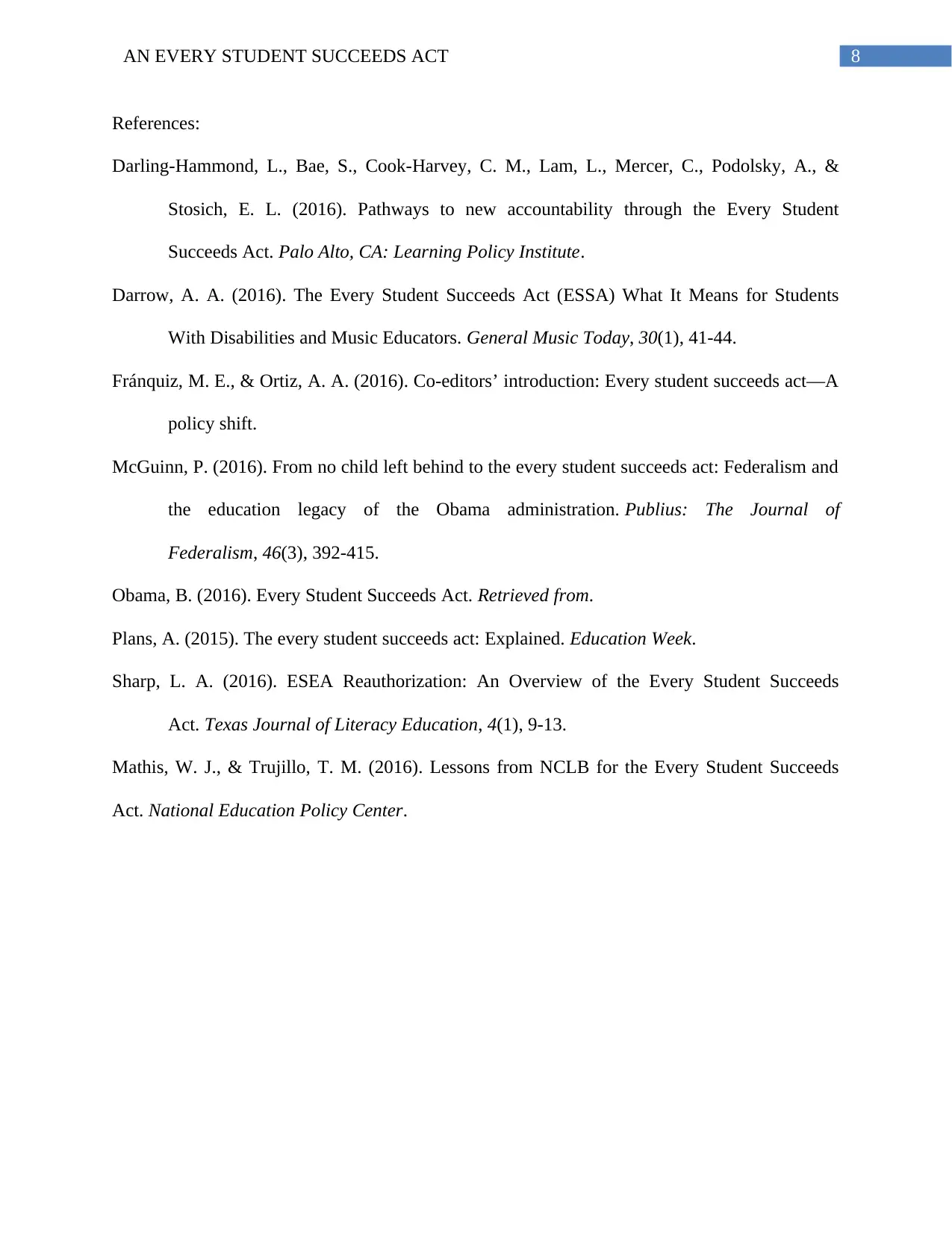
8AN EVERY STUDENT SUCCEEDS ACT
References:
Darling-Hammond, L., Bae, S., Cook-Harvey, C. M., Lam, L., Mercer, C., Podolsky, A., &
Stosich, E. L. (2016). Pathways to new accountability through the Every Student
Succeeds Act. Palo Alto, CA: Learning Policy Institute.
Darrow, A. A. (2016). The Every Student Succeeds Act (ESSA) What It Means for Students
With Disabilities and Music Educators. General Music Today, 30(1), 41-44.
Fránquiz, M. E., & Ortiz, A. A. (2016). Co-editors’ introduction: Every student succeeds act—A
policy shift.
McGuinn, P. (2016). From no child left behind to the every student succeeds act: Federalism and
the education legacy of the Obama administration. Publius: The Journal of
Federalism, 46(3), 392-415.
Obama, B. (2016). Every Student Succeeds Act. Retrieved from.
Plans, A. (2015). The every student succeeds act: Explained. Education Week.
Sharp, L. A. (2016). ESEA Reauthorization: An Overview of the Every Student Succeeds
Act. Texas Journal of Literacy Education, 4(1), 9-13.
Mathis, W. J., & Trujillo, T. M. (2016). Lessons from NCLB for the Every Student Succeeds
Act. National Education Policy Center.
References:
Darling-Hammond, L., Bae, S., Cook-Harvey, C. M., Lam, L., Mercer, C., Podolsky, A., &
Stosich, E. L. (2016). Pathways to new accountability through the Every Student
Succeeds Act. Palo Alto, CA: Learning Policy Institute.
Darrow, A. A. (2016). The Every Student Succeeds Act (ESSA) What It Means for Students
With Disabilities and Music Educators. General Music Today, 30(1), 41-44.
Fránquiz, M. E., & Ortiz, A. A. (2016). Co-editors’ introduction: Every student succeeds act—A
policy shift.
McGuinn, P. (2016). From no child left behind to the every student succeeds act: Federalism and
the education legacy of the Obama administration. Publius: The Journal of
Federalism, 46(3), 392-415.
Obama, B. (2016). Every Student Succeeds Act. Retrieved from.
Plans, A. (2015). The every student succeeds act: Explained. Education Week.
Sharp, L. A. (2016). ESEA Reauthorization: An Overview of the Every Student Succeeds
Act. Texas Journal of Literacy Education, 4(1), 9-13.
Mathis, W. J., & Trujillo, T. M. (2016). Lessons from NCLB for the Every Student Succeeds
Act. National Education Policy Center.
⊘ This is a preview!⊘
Do you want full access?
Subscribe today to unlock all pages.

Trusted by 1+ million students worldwide
1 out of 9
Related Documents
Your All-in-One AI-Powered Toolkit for Academic Success.
+13062052269
info@desklib.com
Available 24*7 on WhatsApp / Email
![[object Object]](/_next/static/media/star-bottom.7253800d.svg)
Unlock your academic potential
Copyright © 2020–2025 A2Z Services. All Rights Reserved. Developed and managed by ZUCOL.





